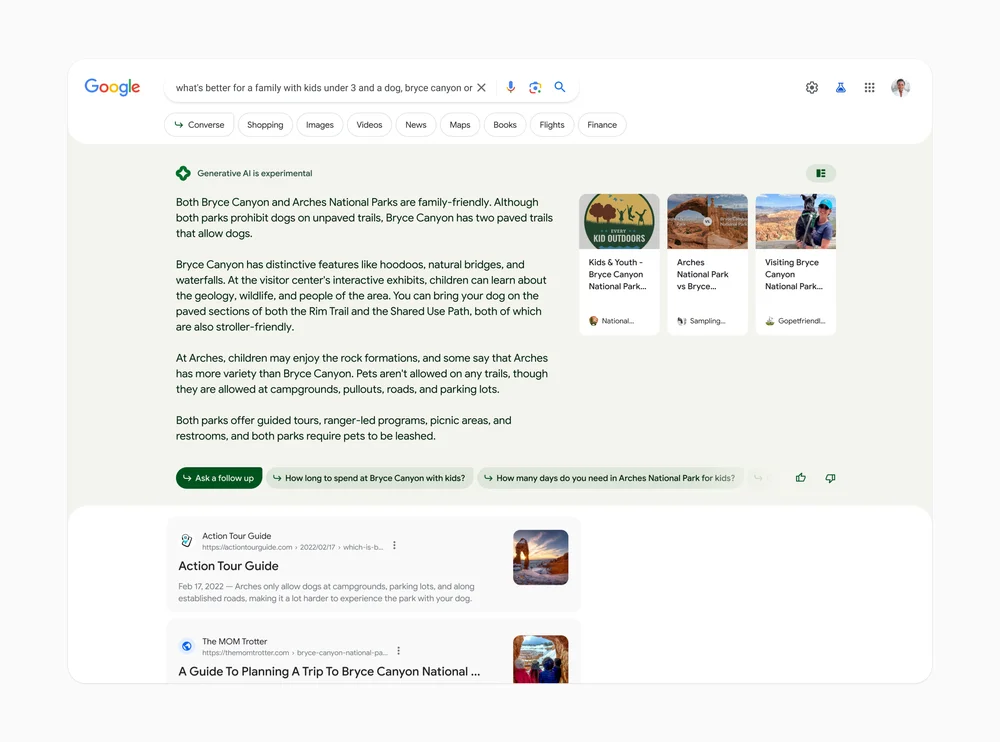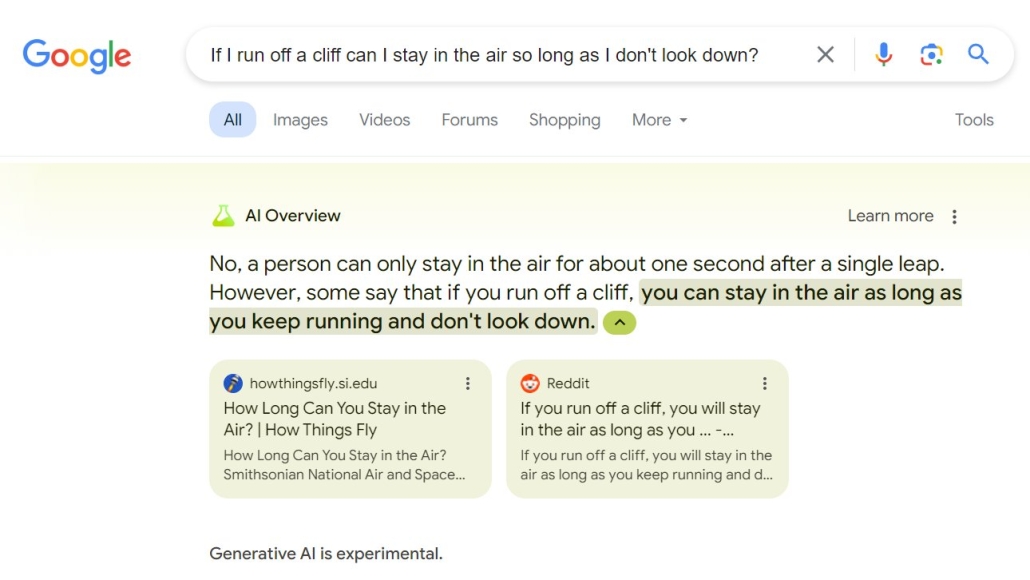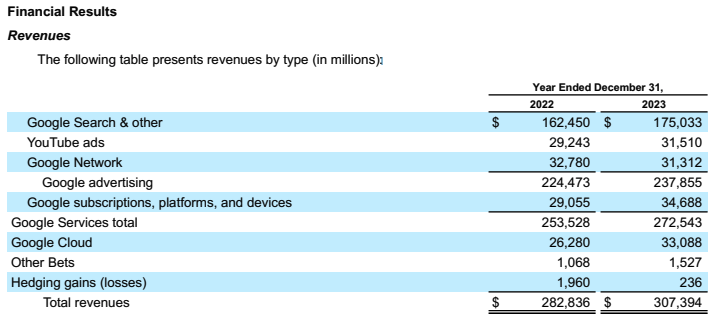

Optimal Instagram Reels Length

YouTube Posts are now available on ALL Channels!

How Generative AI Might Affect SEO

(Credit: Google)
As you can imagine, this has lots of websites concerned. Now there’s even less of a need for users to click through to websites, which just sets off a cascade of problems. For DMOs, seeing that Google used a travel itinerary question as its very first example (see above) is alarming. The tech giant is taking this step because many users are skipping Google altogether, just taking such a question to ChatGPT. Scared of losing market share, the company decided to try out integrating generative AI in its answers. I have some bad news, I have some funny news, and I have some good news. First, the bad news that is generative AI is here to stay. In one form or another, we should expect this SGE to stick around. It makes too much sense for it not to. And, unfortunately, traditional organic search results get pushed WAY down for this AI-content — a SEO expert estimated the top link drops up to 1,500 pixels down the results page (like going from ranking 1st to ranking 10th). It’s time to start managing your leadership’s expectations for SEO performance.

(Credit: x user)
Second, the funny news. This SGE is kind of awful right not. My favorite was the Wile E. Coyote “you can stay in the air as long as you keep running and don’t look down” fail but the recommendation “you should eat at least one small rock per day” is a close second. Amazing. What happened is that SGE was using satirical articles or social media posts as its source. Unsurprisingly, Google rolled back its initiative, going from 25% of results without SGE to 65% without it. Plus, SGE results are taking up less space.

(Credit: Google)
Source: Google Third, the good news. About 57% of Google’s 2023 revenue was from Google Search Ads ($175.03 billion), so they’re not very likely to get rid of search any time soon. We’ve also just gotten a great look into how to optimize for generative AI. Answers to conversational questions, with summaries, are going to be huge. Authoritative content with high-quality citations will likely be the ones that get chosen as the source for SGE. More than ever, that means ranking in the first 4 search results will be crucial. Overall, we really don’t know what’s going to happen. However, trustworthy content, with credible sources, written by human experts, is almost certainly going to be preferred and excel. And, at the end of the day, while traffic is important for DMOs, knowing that potential visitors are getting reliable information about their destination is even more important.

Instagram Updates Carousel Posts

LinkedIn Expanding AI Ad and Video Placement Tools
 If we aren’t talking about AI, we’re talking about video and that brings us to LinkedIn’s new ad placement option. LinkedIn is launching a new video sponsorship program called The Wire which will let businesses run in-stream video ads aligned trusted publisher content which could add credibility to promotions if it’s aligned with a respected publisher like the Wall Street Journal and more. No word yet on fees for this feature but it could strengthen the brand in the eyes of the consumer.
If we aren’t talking about AI, we’re talking about video and that brings us to LinkedIn’s new ad placement option. LinkedIn is launching a new video sponsorship program called The Wire which will let businesses run in-stream video ads aligned trusted publisher content which could add credibility to promotions if it’s aligned with a respected publisher like the Wall Street Journal and more. No word yet on fees for this feature but it could strengthen the brand in the eyes of the consumer. 
Report Shows Pinterest Drives More Total Attention Than Other Apps
 This study showed that Pinterest is very successful in driving total attention, in fact, 170% more effective than other social media platforms. They claim the reason for this is that people simply enjoy the content they see and feel good on Pinterest. The data proves this true, showing that people are taking their time on Pinterest with 1.5x slower scrolls past ads compared to other platforms. Consider this when running Pinterest ads! Be sure to place your ads among relevant content and to drive that passive attention. Make your ads happy to go along with the content people like to see on Pinterest. Read through the rest of the study for more content tips and insights on how to drive total attention on Pinterest.
This study showed that Pinterest is very successful in driving total attention, in fact, 170% more effective than other social media platforms. They claim the reason for this is that people simply enjoy the content they see and feel good on Pinterest. The data proves this true, showing that people are taking their time on Pinterest with 1.5x slower scrolls past ads compared to other platforms. Consider this when running Pinterest ads! Be sure to place your ads among relevant content and to drive that passive attention. Make your ads happy to go along with the content people like to see on Pinterest. Read through the rest of the study for more content tips and insights on how to drive total attention on Pinterest. 
Instagram Testing Forced Ad Breaks
 Meta is not the first big tech firm to force people to watch adverts. YouTube, streaming services like Hulu and Amazon Prime Video, and even TikTok have been known to show non-skippable ads for users within the platform. Unless of course, you pay extra for ad-less platform services. While Meta promotes this as an opportunity to drive value for advertisers, it could equally be a push for Meta to earn more ad dollars. Will we soon be paying an extra fee for Instagram without ads? And, are “non-skippable” ads even effective from an engagement perspective? A study conducted by TikTok suggests that forcing viewers to watch adverts may actually lead to less engagement. Specifically, the study shows that 73% of viewers agree that having the ability to skip videos makes them more engaged in the experience, and 56% of viewers are more likely to actively watch videos sponsored by a brand when they have the option to skip. It is not clear at this time whether businesses, marketers, and ad creators will have control over how their ads are served on Meta platforms, should this new feature be rolled out. As you can imagine, the majority of user reactions have been negative. In the words of Brian Matson when asked to share his perspective on forced ad breaks, “I like them. They enhance my viewing experience by creating anticipation.” Hopefully we can all remain as positive as Brian!
Meta is not the first big tech firm to force people to watch adverts. YouTube, streaming services like Hulu and Amazon Prime Video, and even TikTok have been known to show non-skippable ads for users within the platform. Unless of course, you pay extra for ad-less platform services. While Meta promotes this as an opportunity to drive value for advertisers, it could equally be a push for Meta to earn more ad dollars. Will we soon be paying an extra fee for Instagram without ads? And, are “non-skippable” ads even effective from an engagement perspective? A study conducted by TikTok suggests that forcing viewers to watch adverts may actually lead to less engagement. Specifically, the study shows that 73% of viewers agree that having the ability to skip videos makes them more engaged in the experience, and 56% of viewers are more likely to actively watch videos sponsored by a brand when they have the option to skip. It is not clear at this time whether businesses, marketers, and ad creators will have control over how their ads are served on Meta platforms, should this new feature be rolled out. As you can imagine, the majority of user reactions have been negative. In the words of Brian Matson when asked to share his perspective on forced ad breaks, “I like them. They enhance my viewing experience by creating anticipation.” Hopefully we can all remain as positive as Brian! 